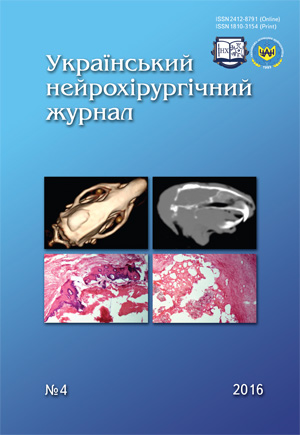MR monitoring in the intervertebral discs changes in patients undergoing autologous chondrocytes transplantation after lumbar microdiscectomy
DOI:
https://doi.org/10.25305/unj.86581Keywords:
MRI, operated intervertebral disc, lumbar microdiscectomy, autologous chondrocytes transplantationAbstract
Objective. To analyze the diagnostic information of MR monitoring while assessing the changes in operated intervertebral disc (IVD) after autologous chondrocytes transplantation (ACT) in patients undergoing lumbar microdiscectomy.
Materials and methods. The Department of Minimally Invasive and Laser Spinal Neurosurgery of Romodanov Neurosurgery Institute of NAMS of Ukraine in cooperation with Cell Therapy Institute developed and implemented the technique of transplantation of autologous chondrocytes cultured from isolated hernia sequestration. 3 months after microdiscectomy ACT was performed via percutaneous puncture entry in operated in 6 patients. MRI of the lumbar spine was performed in 3, 12 and 24 months after ACT.
Results. There were no recurrences of herniated disc reported in 6 patients in 3 months after the operation. In 12 and 24 months MRI showed four (66.7%) patients to have reparative processes against the background of partial recovery of hydrophilic vertebral pulp. The MR monitoring did not found any complication after microdiscectomy.
Conclusions. The MRI information allows objectify ACT results in patients after microdiscectomy. The degree of ACT positive impact on reparative processes in IVD evaluated by MRI correlated with the initial level of degenerative changes in related regions of the vertebral bodies.
References
Clarenзon F, Law-Ye B, Bienvenot P, Cormier Й, Chiras J. The Degenerative Spine. Magn Reson Imaging Clin N Am. 2016;24(3):495-513. [CrossRef] [PubMed]
Uotkins RG. [Predicting outcomes of surgical treatment in patients with chronic disability due to pain in the lumbar spine]. Vestnik Travmatologii i Ortopedii im NN Priorova. 2002;(3):58-65. Russian.
Simon J, McAuliffe M, Shamim F, Vuong N, Tahaei A. Discogenic low back pain. Phys Med Rehabil Clin N Am. 2014;25(2):305-17. [CrossRef] [PubMed]
Grigorovsky V, Khyzhnyak M, Vasileva I, Shuba I, Gafiychuk Y. [The influence of cultivated autogenous nucleus pulposus cells on structure of intervertebral discs of caudal spine at osteochondrosis model in rats]. Ukrainian Neurosurgical Journal. 2013;(2):28-34. Russian. [Abstract/Full Text]
Shevelev I, Guscha A, Konovalov N, Arestov S. Ispol’zovaniye endoskopicheskoy diskektomii po Destando pri lechenii gryzh mezhpozvonkovykh diskov poyasnichnogo otdela pozvonochnika [Destandau endoscopic discectomy in patients with lumbar intervertebral disc hernia]. Khirurgiya pozvonochnika. 2008;(1):51-7. Russian. [CrossRef]
Vedicherla S, Buckley CT. Cell-based therapies for intervertebral disc and cartilage regeneration - current concepts, parallels and perspectives. J Orthop Res. 2016 Apr 22. [Epub ahead of print]. [CrossRef] [PubMed]
Oehme D, Goldschlager T, Ghosh P, Rosenfeld JV, Jenkin G. Cell-based therapies used to treat lumbar degenerative disc disease: a systematic review of animal studies and human clinical trials. Stem Cells Int. 2015;2015:946031. [CrossRef] [PubMed]
Pedachenko E, Khyzhnyak M, Gorbatyuk K, Pedachenko Y, Krasilenko E, Shabliy V. [The first experience of autologous chondrocytes transplantation after lumbar microdiscectomy]. Ukrainian Neurosurgical Journal. 2014;(4):46-9. Ukrainian. [Abstract/Full Text]
Downloads
Published
How to Cite
Issue
Section
License
Copyright (c) 2016 Eugene Pedachenko, Oksana Zemskova, Mykhaylo Khyzhnyak, Yuriy Pedachenko, Kostyantyn Horbatyuk

This work is licensed under a Creative Commons Attribution 4.0 International License.
Ukrainian Neurosurgical Journal abides by the CREATIVE COMMONS copyright rights and permissions for open access journals.
Authors, who are published in this Journal, agree to the following conditions:
1. The authors reserve the right to authorship of the work and pass the first publication right of this work to the Journal under the terms of Creative Commons Attribution License, which allows others to freely distribute the published research with the obligatory reference to the authors of the original work and the first publication of the work in this Journal.
2. The authors have the right to conclude separate supplement agreements that relate to non-exclusive work distribution in the form of which it has been published by the Journal (for example, to upload the work to the online storage of the Journal or publish it as part of a monograph), provided that the reference to the first publication of the work in this Journal is included.









